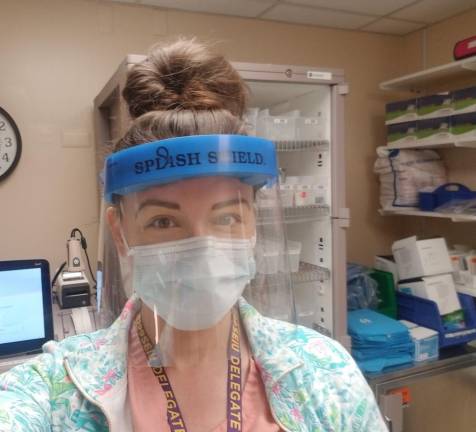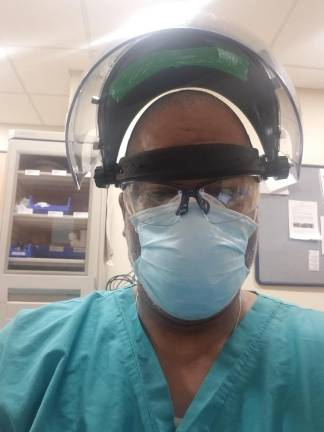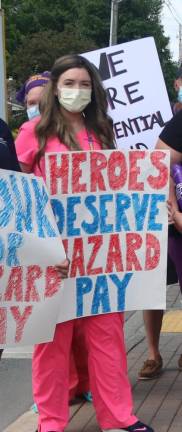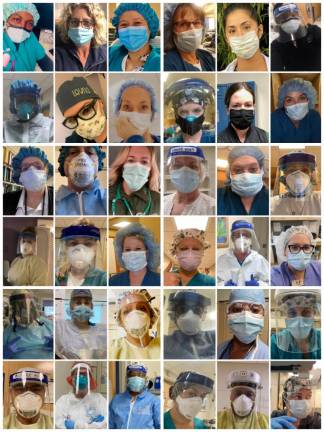Doctors and nurses feel alone and angry as they gear up for the next wave
Covid. Between public apathy and a stressed medical system, medical workers are left shouldering the burden of Covid-19.




When Caitlin Rollman, an ICU nurse at Bon Secours Community Hospital in Port Jervis, N.Y., started feeling awful after tending to a Covid patient, she called around for a Covid test. And around, and around.
“I had to call five different places,” said Rollman, 38. “Every place was completely booked until the weekend. So I drove 40 minutes from my house” in Port Jervis to Excel Urgent Care of Goshen, N.Y. “I felt like death, so having to drive all that way was quite an ordeal for me, and then I had to wait over two hours in my car before they could do the test. By the time I got home, I could barely move I was so sick.
“I went from feeling absolutely fine to within a two-hour period feeling intense body aches, a cough, I had a fever right away, I had trouble breathing. I just felt sicker than I’ve felt in my life. And then of course I worried, because I know that I’m taking care of Covid patients and I have a preexisting condition. I have bad asthma, so that had me worried as well with the shortness of breath.”
The physician who tested her earmarked the sample as high priority. But even so, despite multiple calls to the lab, it was not until six days later that Rollman got her result – and that was only after taking to social media, tagging the lab, BioReference, to pressure them. (BioReference had not responded to an inquiry by press time.) As Rollman suspected, she had Covid.
During our interview, Rollman was convalescing, and coughing occasionally. She doesn’t know whether she got Covid at work, where she was hyper-cautious, or from her boyfriend, who was currently awaiting the results of his Covid test, after discovering there had been an outbreak at his job. What she does know is that many people in Port Jervis don’t have access to the internet, or a car, or a college education, or are elderly and don’t know how to Google testing sites. How many would have given up on getting tested and gone about their business when they started feeling better, spreading the virus?
“I mean, the mayor of New York is on the news telling healthy people to go get tested because they want to bring the rolling average down,” said Rollman. But, as a result, “you don’t have enough resources to result the sick people’s tests in a timely manner.” And this is the state of things when we haven’t yet approached the peaks she’s been reading about in the West Coast and Midwest. The first Covid patient of this wave had come into Bon Secours only about two weeks earlier. She’s been keeping tabs on her patient: still alive.
These kinds of tears in the fabric of our healthcare system can undermine all the painstaking precautions that hospitals and conscientious individuals are taking. “With the second wave, I do feel like our hospital’s much better prepared,” said Rollman. “The managers are very supportive. Everybody seems to be really onboard with everything.”
After a steep learning curve, they now know to “prone” patients, or put them on their stomach, which helps their lungs expand; and to keep them hydrated to prevent kidney problems. They have convalescent plasma and new medications like the antiviral drug Remdesivir. With inpatients – unlike with Rollman’s own experience out in the community – the hospital has a rapid test machine, so they know before they hit the floor whether they have Covid. “That’s better, we can do more targeted treatment,” she said. “We’re not wasting treatments that are meant for Covid patients.”
A spokesperson for Westchester Medical Center Health Network, which includes Bon Secours, said in a press release: “As a network, WMCHealth has been planning for and developing surge capacity options for our facilities for some time, working in concert with local, state and federal authorities. We are confident in our preparation and ability to handle an increase in patients safely.”
A New York State mandate ordering hospitals to stockpile 90 days of personal protective equipment is some comfort, said Rollman. “However, I find that there’s still a distrust of the healthcare system, given what everybody went through with the first wave,” she said. “Like, do we really have 90 days’ worth of supply? Some of the managers say yes, some say, well, not if we’re filled to the gills with Covid patients.” Should nurses be saving their gowns, their N-95 masks? “There’s just that underlying worry,” said Rollman. “Even though things are okay now, we’re not sure if they’re going to stay that way.”
Rollman got her ICU job – transferring from an oncology department – when another nurse, due to retire in 2021, called it quits after the first Covid wave. “In one aspect I was happy to go back because that’s what I love,” said Rollman, who began her career 15 years earlier in an ICU. “In the other aspect, it’s scary. The amount of treatment that goes into a Covid patient is insane. You’re there for 13 hours. I may be gowned up and sweating for 10 of those 13 hours because they require so much care.”
Across the country, thousands of medical practices are closing, The New York Times reports, as doctors and nurses decide to retire early or shift to less intense jobs. It’s not hard to see why. Rollman went into her own Covid ordeal already “livid” at her employer for not providing hazard pay, like many hospitals did after the first wave. A member of 1199 SEIU, the largest healthcare union in the country, she had picketed with colleagues, holding a sign that said “Heroes deserve hazard pay,” to no avail.
“We were the only health system in the Hudson Valley that did not receive hazard pay,” she said. “We got no appreciation. Money at the end of the day isn’t everything, but some kid of appreciation.” All she and her colleagues got was a pair of socks and a T-shirt that said Westchester Medical Center. Helene Guss, director of communications for Westchester Medical Center and Bon Secours Charity Health system, declined to comment on the hazard pay issue.
With a new understanding of this gruesome sickness as both a patient and caregiver, Rollman is anxious about what’s coming down the pike. The first Covid patient of this wave had arrived at the Bon Secours intensive care unit two weeks before we spoke. “It’s starting to trickle in,” said Rollman. “We’re hoping that it kind of stays that way, it doesn’t end up being that the entire ICU is full and now we’re overflowing into other departments and we’re pulling staff,” she said.
“I’m hoping there’s going to be a community buy-in now that the numbers are starting to rise again,” she said. “I’m hoping that the community is now going to be like: hey we don’t want a second wave to come. So let’s wear a mask, let’s social distance, let’s be involved in the system so that we’re not overwhelmed again,” she said. “But time will tell, I guess.”
‘Like being lost in the sea’
None of the accoutrement of dread – the mobile morgues, the tent out front – have returned yet to St. Anthony Community Hospital in Warwick, N.Y., where maternity nurse Jessica Lawlor tended to Covid-positive mothers through the first wave. Nor, when we spoke in mid-November, had they had any Covid cases on the labor and delivery floors since then. But the emergency room is once again seeing a trickle of Covid patients sick enough to need hospitalization.
“I think I’m a little bit in denial because it sounds like all signs are pointing toward we’re going to be right back where we were in spring,” Lawlor said. “But I have just a very, very difficult time actually believing that, even as I’m saying it out loud. And I think it’s just dread: oh God, no, please, please no.”
She said St. Anthony is better prepared this time, with rapid-testing for all incoming patients, personal protective equipment and quarantine rooms at the ready, a public that gets it about masking and no-visitor policies, and a better grasp of the medicines and therapies that work in lowering the death rate – and which treatments, like ventilators, may not be the answer.
“One of the biggest lessons is in preparation,” she said – not just on an institutional but also on the individual level. Lawlor had gotten a frantic call from a friend on the Monday we spoke. Someone at the baby shower her friend attended over the weekend had tested positive for Covid. She then had dinner with her parents, who fall into the high-risk category. “So for me, it was that kick in the butt,” said Lawlor. “I hadn’t even ordered the swabs.” Her next call was to a lab to order the supplies that would allow her to test people for Covid herself, from outside her home in Port Jervis. The results take three or four days to come back, but it’s “so much less stressful” than trying to track down a test at an overburdened testing site.
But all the preparations and precautions in the world won’t have much effect if they’re not being instituted consistently – which Lawlor has come to realize they’re not. During a medical visit of her own, which necessitated a trip to a Covid testing facility in Port Jervis, Lawlor found herself in an open cubicle in close quarters with an unmasked, coughing boy. “I was furious,” she said. “I wasn’t scared for myself,” but on behalf of the mostly elderly people who would be the demographic coming in to be tested in advance of procedures.
“If there’s one overriding feeling for me, it’s sort of like being lost in the sea,” she said. “If that’s going on there, what actual precautions on a regular basis, consistently, are we all really taking? Or are so many of us apathetic at this point that we’re actually not mitigating as much as we’re giving lip service to?”
She wonders whether a lack of clear information may be partly to blame for a mounting sense of public apathy. Do those rising numbers of positive cases we’re hearing about represent genuinely sick people, or not?
“Are we all just so tired at this point that more and more of us are just feeling like, whatever?” she said. “Whoever’s going to get sick is going to get sick?” Between institutional inconsistency and public apathy, a lot of pressure will fall on the medical gains that have been made over the last nine months to make this wave less deadly than the last, she said.
Lawlor gets it about quarantine fatigue. She’s sick of it, too. “I want to dance, I want to be with friends, I want to see music,” she said. “All those things it was easy to say – you’re going to have put that aside, now it’s exasperating and sad. It’s like, oh my God, are we going to do normal life ever again? I really feel that.” As a former midwife, a mom and now a nurse in a global pandemic, Lawlor does her best to take self-care seriously. In addition to her shifts at St. Anthony’s, she will be starting a 13-week stint as a travel nurse at New York Presbyterian Hospital in Bronxville, N.Y., shortly, a structure that will give her the freedom to take much-needed breaks. If all goes as planned, she will be on the Bread and Puppet Theater four-month cross country tour starting in February, performing with the radical political theater troupe, blowing off about a year’s worth of steam.
‘It feels like there is no plan’
Another longtime trauma nurse who works at a local hospital agreed to speak anonymously, for fear of reprisal, and will be called Nurse X. Nurse X watched 90 percent of the patients who came into the ICU during the first wave die at a pace that recalled nothing so much as the AIDS epidemic. “I’m a trauma nurse, so I understand disaster,” said Nurse X. “In medicine sometimes there’s no answers, we get it. But now, second time around, you kidding me? There’s no lessons learned?”
As the Covid patients begin to trickle back in, no plan has been communicated from above, said Nurse X. “This next time around, I don’t think anyone’s seeing any changes. They might have a little bit more PPE and stuff, but the plan, it feels like there is no plan.”
During the first wave, nurses were changing out of contaminated scrubs in their own garages. Some who had vulnerable people at home were sleeping in trailers. But that was in the spring and summer. How is that going to work when it’s 20 degrees below zero out? “A lot of nurses are very upset, especially the ones with little children or elderly people in their homes,” said Nurse X. “They’re very, very scared. I think a lot of people will go in if they absolutely have to, because of who and what nurses are, but I think they will be a little bit more demanding.” Last time around, some nurses were being worked up to seven days a week, or being floated between clean and infected areas without proper precautions, said Nurse X, who came down with an excruciating case of Covid during the first wave.
Last time, nurses wore the same gown for a week and used their N-95 mask until it fell apart. “The basics went out the window,” which was understandable then because they got “caught with our pants down.” Some of those issues have been ironed out, but not nearly all, said Nurse X.
Nurse X is voicing concerns shared by a vast majority of the nursing profession. A November report from National Nurses United found that only 18 percent of registered nurses in hospitals report any preparation for surge capacity and planning. “Hospitals are continuing to fail when it comes to preparation for Covid-19, even as flu season begins,” said National Nurses United Executive Director Bonnie Castillo. “They have had nearly a year to get their act together. We should not still be operating under crisis standards of care. Their lack of preparation means they are knowingly sacrificing the lives of nurses and other health care workers. More than 240 registered nurses have died from Covid-19. Enough is enough.”
Why is there no gathering within each hospital to share best practices of care, and then across states, regions and the nation? “If that’s being done, it’s really quiet. And why should it be quiet?” said Nurse X. “We’re intelligent people. We’ve been through some stuff, a lot of us have been in the military. A lot of us can probably help. There’s no inclusion, everything’s at the top.”
Nurses have been doing their own research on their phones, checking medical journals to see what advances are in the works. The answer, said Nurse X, is pretty much nothing until the vaccine comes out, likely the middle of next year. “Why is everyone remaining so uninformed, and not planning for the next one? We’re waiting for the shoe to drop – and then we’ll do something. I think we can do better than that.”
What makes Nurse X angriest, though, is the people who refuse to wear masks. “I’m upset that there are so many stupid people in the world,” said Nurse X. “I call them low-information people.” This wave is likely to be less deadly than last because nursing homes are restricted now, “so we’re not going to get that horrid downflow.” But it could be less deadly still if not for the rallies and parties of unmasked 20- and 30-year-olds. “They don’t see it. And their world is, well it hasn’t hit me.”
Nurse X grew up a time and place where “you mow your grass, and you mow the little lady next door’s grass.” Yes, the young people refusing to mask up will probably be fine, said Nurse X, but “they’re going to kill their grandparents and their aunts and uncles.”
‘This will be you in the bed’
“We’re not more prepared, per se,” said Dr. Doug Fletcher, a pulmonologist at Middletown Medical and Garnet Health Medical Center (formerly Orange Regional Medical Center). “We know how to break the hospital up so that we have everybody in the right areas and where we’re going to designate people. In terms of handling it, people have an idea of how bad it can be. We know what it can do, the worst scenarios.”
At its hospitals and doctor offices, Garnet Health is screening patients before appointments, staggering appointment times, socially distanced registration and waiting areas, temperature checks, frequent hand-washing and curbside check-in at Urgent Care, stringent cleaning using ultraviolet light devices and special decontamination misting machines, and offering telehealth options, according to spokesman Rob Lee.
“But in terms of the treatment, it’s no better, because we still really don’t have a treatment,” said Fletcher. They have figured out a regimen that might include Remdesivir, the immunosuppressant Tocilizumab, the steroid Dexamethasone, and convalescent plasma, but the results are inconsistent. “There’s no guarantee they won’t worsen by day three or four,” he said. “So we still don’t have control of it.”
What’s more, he said, many of his colleagues have yet to recover from the trauma of the first wave. “It’s sort of PTSD,” he said – it’s a strong term, but one that another nurse used too.
“It’s a fear that comes over you, that this will be you in the bed,” he said. “This can be you. What happens if I can’t take care of my family? What happens if I give it to someone? And it doesn’t leave you, because the disease didn’t get better. It’s ongoing. It’s not like going to Vietnam and then being there and coming home. The war’s still going on. We got a little bit of respite when people were wearing masks and social distancing, but then the guard went down because the numbers went down.”
The main thing that doctors and nurses have going for them this time around is each other. “Only we can understand how bad it can get,” he said. “We really learned to become a team. That’s where we have a little bit of an advantage. We know how to triage, we know who’s going to be doing what. That’s going to help us,” said Fletcher.
During the first wave, Fletcher would find a room where he could just cry. Now he and his colleagues are battle-hardened, for better or worse. “We’ve just learned to become numb, and do what we have to do,” he said. “Before we were scared. Now we’re more numb. And scared.”
He didn’t want to bring the stories home to his wife. There was the 38-year-old man whose son thanked Dr. Fletcher over the phone, asking him to get his daddy home in time for his sister’s birthday – knowing that he was helpless to save the boy’s dad, and that it would fall to him to tell the family.
The young people he lost were tragic, but so were the old ones. There was the 75-year-old woman who’d just gotten a new car; the judge who’d just gotten elected to the Supreme Court. “God gave them the ability to get to that age, and then Covid takes them,” said Fletcher. Now he sees people walking around without masks, and “it’s like these people died in vain.”
In the face of mounting public apathy, “You feel lonely. You feel like in the medical community you’re by yourself, because nobody understands it. You’re on an island,” said Fletcher. “But that’s what brings us together.”
For the first time in his 30-year-career, Fletcher was scared by this virus. “I never went to work that I was scared. You have people that have horrific injuries and diseases – but they never could really touch you. Now all of a sudden it can get you. Then if you get it, you don’t have a treatment either, just like they don’t have a treatment.” He had nightmares, and worried about bringing the disease home to his wife and daughter in Chester, N.Y., or giving it to his sister who’d had a stroke. He has not seen her in a long time. “When it gets you, you might be okay,” he said. “You don’t know what it’s going to do to you – you may be fine, a few aches and pains, or you may be on the vent with no kidney function.”
At one point during the first wave, feeling sick, he went to the emergency room for a test and was told he wasn’t sick enough to be tested. Shortly afterward, his group, Middletown Medical, started testing, and he was the first patient. He was negative.
The shortage of personal protective equipment last time was as unacceptable as it was unavoidable, said Fletcher. If we see the same kind of surge as last time, he expects that disaster to replay itself. “Will it become a problem again? Sure it will, it definitely will, if we get to those numbers. That’s the scary part.”
Knowing better than anyone the risks of this virus, doctors and nurses have no choice but to brave them, even when that means toting around a soggy mask in a paper bag. “This is your job, and you’ve got to go out there every day. It’s scary, you don’t want to go out. But you know you’ve got try to help as best you can,” said Fletcher.
“Then you get people who say ‘Oh, it’s made up.’ Intelligent people,” he said. “Those are the people you feel like punching.”
“It’s a fear that comes over you, that this will be you in the bed. What happens if I can’t take care of my family? What happens if I give it to someone? And it doesn’t leave you, because the disease didn’t get better. It’s ongoing. We got a little bit of respite when people were wearing masks and social distancing, but then the guard went down because the numbers went down.” Dr. Doug Fletcher